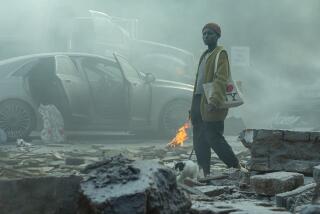‘After.Life’
- Share via
The afterlife in “After.Life” is deadly. Really.Deadly.
It’s where the not-quite dead exist before they finally cease to, specifically a cold back room in a ghastly funeral home somewhere in the Midwest. According to “After.Life,” which stars Christina Ricci and Liam Neeson, it takes a human being about four days to stop being, depending on scheduling and how long the undertaker wants to chat.
The afterlife is not, however, nearly as deadly or as ghastly as the movie itself, an undertaking so tortured that it digs a deeper grave with every passing scene.
The undertaker in question is Neeson’s Eliot Deacon, who fills his time discussing the value of life with the soon-to-be deceased while draining blood from bodies, repairing holes with large surgical needles, and working on floral arrangements for the After.Party (or funeral, if you prefer). The body he’s spending the most time with is Ricci’s Anna, who despite the car accident, the gash on her head, the cold slab under her bum and the coroner’s report Eliot’s waving in her face, doesn’t believe she’s a goner.
That conundrum is the film’s central conceit, and it’s Eliot’s job to get her (and us) to believe, and frankly he’s fed up with debating the facts of life with yet another ungrateful corpse. After all, Anna might not be in this predicament if she hadn’t been texting while she was driving. At night. In the rain.
Except for the crash and the whole texting incident, most of the action here has to do with clothes, which may make the man but not the movie, which is neither horrific enough to scare, nor psychologically thrilling enough to even register a pulse. And whatever fun there is to be found, and there were hoots aplenty, it’s of the “laughing at, not with” variety.
But back to the clothes. With Anna, there’s her dress to cut off, revealing a silky red slip that will also be slowly removed (red is the primary color abused here). Eventually she’s naked, which she is for about half of the film, and dead, which she must be because there are no goose-bumps on that bare body even though Eliot makes a big deal of turning down the thermostat every other scene.
Most of the movie, writer-director Agnieszka Wojtowicz-Vosloo’s unfortunate first feature shot in late 2008, unfolds in the moments after Eliot’s been interrupted. And he gets interrupted a lot, usually by a tearful relative (in one case, a cop who cops a feel of Anna after saying goodbyes to a brother on a slab nearby. Gallows humor, I guess.).
Meanwhile, poor Justin Long. He’s Paul, Anna’s very sad boyfriend, a character Long seems to be playing a lot these days (remember “Drag Me to Hell”?). I say poor Justin Long because he’s one of the few putting any life into their role, though the dialogue is so obvious there’s not much to work with. When Anna wonders during one of her conversations with Eliot whether she’s actually in hell, it’s tempting to scream, “Yes, Anna, you are, and you’re not alone.” (The filmmaker shares writing credit with Paul Vosloo and Jakub Korolczuk.)
Anastas N. Michos, who created the bluesy mood of “Cadillac Records,” is the director of photography and working with Wojtowicz-Vosloo created a look that showed some promise, a kind of arty minimalism where even the tools of the undertaking trade are beautiful in the right light. But just as it gets intriguing, it goes ridiculously rogue, and red, as in blood red, get it?
More to Read
Only good movies
Get the Indie Focus newsletter, Mark Olsen's weekly guide to the world of cinema.
You may occasionally receive promotional content from the Los Angeles Times.











